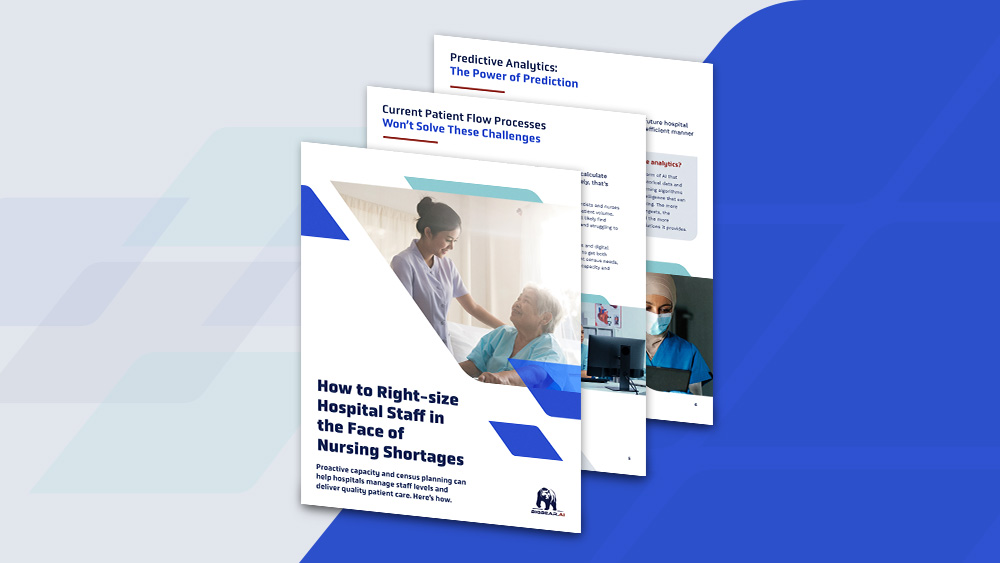Building a Better Hospital Master Plan with Predictive Analytics, Not Spreadsheets
Digital twins and predictive analytics can help power smart operational planning

Every hospital has a master plan that outlines the organization’s growth and future development strategy. Master plans typically look at timelines from two to 10 years and include everything from construction needs to budget requirements. The goal is to create a right-sized facility that accommodates a community’s future, and often fluctuating, needs.
But several external factors have made master planning a significant challenge, including:
- Population growth, especially at local levels. The State of Texas, for example, is expected to experience steady growth over the next few decades, particularly in suburban areas.
- An aging population. In 2030 all baby boomers in the U.S. will be older than 65 years of age, and older adults will outnumber children by 2034. This indicates a steadily aging population that will likely result in more patients to accommodate and longer hospital stays.
- Customized care and the move toward value-based and tailored healthcare services make it difficult for hospitals to accurately predict the types of facilities they’ll need for their patient mixes. This will create challenges in their planning processes.
Trusting Multi-million Dollar Investments to…a Spreadsheet?
A hospital spending between $60 to $187.5 million on average on new construction or $1.5 million on a single bed cannot afford to have an inaccurate master plan. The plan needs to be flexible enough to accommodate potential future fluctuations in growth and capacity. But it also needs to be right sized appropriately so the hospital does not spend money building wings or beds that may not be necessary.
Right now, most hospitals aren’t achieving this objective. They’re still relying on highly manual processes and technologies when building their master plans, including old-fashioned spreadsheets and business intelligence software.
While these practices might provide some insights into potential levels of need over the next few years, they’re still mainly based on educated guesswork. Estimates will likely be wide-ranging and inaccurate because existing processes fail to consider the lifecycle of actual patients as they move throughout the hospital.
Building a Master Plan Based on Historical Data, not Guesswork
Hospitals have high levels of complexity that must be considered. That’s why building a master plan based on historical patient data, predictive analytics and demographic information is a better and more effective strategy than spreadsheets or even business intelligence software.
By automatically combining different factors – including patient data, anticipated population numbers, the average age of local residents, and more – a hospital can conduct a What-if Scenario Analysis (WISA) to show what might happen given certain variables, from seasonal disease surges to population booms. This is done in a digital twin where possibilities can be re-run and re-analyzed as often as needed.
A WISA is created using several data points, including anonymized information from past patients’ electronic health records. It’s based on historical data and can show the impact different variables and process changes can have on hospital operations and census capacity – even years later. Those data points are then ingested into a predictive data analytics program that models an individual patient.
That patient’s data is combined with data from patients with similar ailments and demographic profiles and fed into a discrete-event simulation (DES) process. The DES accurately predicts how long a patient is likely to be hospitalized, where they’re liable to go while in the hospital, and more. This intelligence can help hospitals right-size their master plans and ensure they have enough capacity and flexibility to manage almost all possible scenarios, years into the future.
Predictive analytics, digital twins, WISA, and DES are all driven by machine learning capabilities that get smarter over time, resulting in more accurate insights. When a hospital experiences a surge (perhaps during this year’s upcoming flu season , for example), the system collects information on that surge and can apply it to next year’s predictions. The more information collected, the better the system will become at predicting future surges and needs.
Hospitals can use this information in conjunction with external data points to inform capacity and resource planning. For example, a hospital can combine its own WISA with external data pertaining to anticipated population growth (or contraction), or the demographic profile of the region where they’re intending to build. This will give the hospital a better and more accurate understanding of how much they’ll need to build, how many beds they’ll need to invest in, and so forth.
With an ML-based WISA, hospital administrators can look at different surge possibilities during a flu season and test how those surges will impact capacity. That information can be used to build long-term master plans that account for seasonal increases and ensure the right resources are in place to handle best, worst, and anything-in-between scenarios.
Flexibility is the Key to Better Master Planning
All these technologies and approaches can provide hospitals with accurate, yet flexible, long-term master plans.
For instance, children’s hospitals are dealing with large spikes in respiratory syncytial viruses (RSVs). With the right data, hospitals can predict these surges and plan flexible solutions to manage capacity around time periods when RSV is likely to be prevalent. An example would be creating units that can be easily converted from their core purpose into respiratory care centers.
Hospitals need to build facilities and invest in resources that are flexible and can scale to handle capacity surges, population booms, the influx of older patients, and more. The best way to do that is by building a master plan based on data-driven decisions.
Digital twins that are updated with the most recent patient information offer a great advantage. They are always available and ready to provide an accurate representation of a facility in real-time, so that administrators can adjust on the fly and make changes based on existing or potential scenarios. Administrators no longer need to track down a person or spreadsheet, and information is updated in minutes, not days. This is critical, especially when dealing with patients’ lives.
Providing Hospitals with a Better Master Plan – Learn more
Ready to learn more about predictive analytics, discrete-event simulation, and What if Scenario Analysis and how they can be used in long-term master planning?
FutureFlow Rx creates a digital twin of your hospital system to create a flexible master plan for your hospital environment based on historical patient data. Learn more about our AI software solutions for hospitals by downloading our white paper: Preparing for a Tripledemic: Resource Planning in the Face of Covid-19 / Flu / RSV




